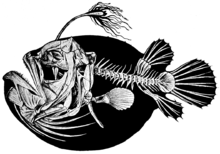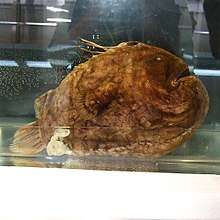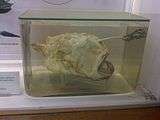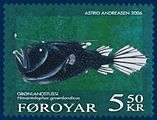Footballfish
The footballfish form a family, Himantolophidae, of globose, deep-sea anglerfishes found in tropical and subtropical waters of the Atlantic, Indian, and Pacific Ocean. The family contains c. 22 species all in a single genus, Himantolophus (from the Greek imantos, "thong, strap", and lophos, "crest").
| Footballfish | |
|---|---|
 | |
| Himantolophus groenlandicus | |
| Scientific classification | |
| Kingdom: | |
| Phylum: | |
| Class: | |
| Order: | |
| Family: | Himantolophidae |
| Genus: | Himantolophus J. C. H. Reinhardt, 1837 |
| Species | |
|
| |
Description
As in other deep-sea anglerfish families, sexual dimorphism is extreme: the largest females may exceed lengths of 60 cm (two feet) and are globose in shape, whereas males do not exceed 4 cm (1.5 inches) as adults and are comparatively fusiform. Their flesh is gelatinous, but thickens in the larger females, which also possess a covering of "bucklers" — round, bony plates each with a median spine — that are absent in males. Both are a reddish brown to black in life.
In females, the mouth is large and oblique. The subequal jaws are anteriorly lined with rows of numerous close-set, depressible, and retrorse teeth; vomerine teeth are absent. Footballfish females differ from those of other ceratioid families by their shortened, blunt snout; along with the chin, it is covered in sensory papillae. Originating above or slightly in advance of the small eye is an illicium (the "fishing rod") and at its end a bioluminescent, bulbous esca (the "fishing lure", its light owing to symbiotic bacteria). Escal morphology varies between species, and it may or may not possess denticles or accessory appendages, the latter either branched or unbranched. The pterygiophore of the illicium does not protrude from the snout, and there is no hyoid barbel.
At maturity, the streamlined males have an enlarged posterior nostril (with 10 – 17 lamellae); slightly ovoid eye with an enlarged pupil creating a narrow anterior aphakic space; no ilicium or esca; and the head and body is covered in dermal spinules, those along the snout midline being enlarged. The jaw lacks teeth, whereas those of the denticular bone have fused into a larger mass; the upper denticular bone possesses 10 – 17 hooked denticles.
In both sexes, the fins are spineless: the single dorsal fin with 5 – 6 soft rays, the pectoral fins with 14 – 18, the anal fin with four, and the caudal fin with 19. There are six branchiostegal rays and 19 vertebrae; the parietal is lacking throughout life, there are no epurals, and the pelvic bone is triradiate.
Life history
The football fish was first discovered in the early 1900s by deep sea fisherman in search of flounder. Their poor musculature and cumbersome morphology indicate that mature female footballfish are probably poor swimmers and largely sedentary, lie-in-wait predators. They are primarily mesopelagic, living in open water, with very few caught below 1,000 m (3,280 ft). Females are carnivorous and feed upon other pelagic fish (such as lanternfishes and ridgeheads) and cephalopods, as well as shrimp and euphausiids that are presumably attracted to within striking distance by the footballfish's luminous lure.
Upon maturity, the tiny males of most species metamorphose into a parasitic form, which lacks both a lure and true teeth and is presumed not to feed. The parasitic males use their enlarged olfactory bulbs (as indicated by their enlarged nostrils) and sensitive eyes to home in on the pheromones and possibly the species-specific lures of females. The metamorphosed males attach themselves to the body of the female using their denticular hooks; the male's tissues then begin to coalesce with the female's, and the former's gonads begin to develop while all other organs degenerate. The male thus becomes inseparable from the female, deriving nourishment directly from her blood.
Footballfish are presumed to be non-guarders that spawn pelagically. Their larvae are epipelagic (occurring in the well-lit 200 m of the water column), indicating they probably undergo an ontogenetic descent into deeper waters as the larvae mature. Predators of footballfish include sperm whales and other footballfish.
Species
There are currently 22 recognized species in this genus:[1]
- Himantolophus albinares Maul, 1961
- Himantolophus appelii F. E. Clarke, 1878 (Prickly anglerfish)
- Himantolophus azurlucens Beebe & Crane, 1947
- Himantolophus borealis Kharin, 1984
- Himantolophus brevirostris Regan, 1925
- Himantolophus compressus Osório, 1912
- Himantolophus cornifer Bertelsen & G. Krefft, 1988
- Himantolophus crinitus Bertelsen & G. Krefft, 1988
- Himantolophus danae Regan & Trewavas, 1932
- Himantolophus groenlandicus J. C. H. Reinhardt, 1837 (Atlantic footballfish)
- Himantolophus litoceras A. L. Stewart & Pietsch, 2010 [2]
- Himantolophus macroceras Bertelsen & G. Krefft, 1988
- Himantolophus macroceratoides Bertelsen & G. Krefft, 1988
- Himantolophus mauli Bertelsen & G. Krefft, 1988
- Himantolophus melanolophus Bertelsen & G. Krefft, 1988
- Himantolophus multifurcatus Bertelsen & G. Krefft, 1988
- Himantolophus nigricornis Bertelsen & G. Krefft, 1988
- Himantolophus paucifilosus Bertelsen & G. Krefft, 1988
- Himantolophus pseudalbinares Bertelsen & G. Krefft, 1988
- Himantolophus rostratus Regan, 1925
- Himantolophus sagamius S. Tanaka (I), 1918 (Pacific footballfish)
- Himantolophus stewarti Pietsch & Kenaley, 2011
Gallery
References
- Froese, Rainer and Pauly, Daniel, eds. (2014). Species of Himantolophus in FishBase. August 2014 version.
- Stewart, A.L.; Pietsch, T.W. (2010). "A new species of deep-sea anglerfish, genus Himantolophus (Lophiiformes: Himantolophidae) from the Western South Pacific, with comments on the validity of H. pseudalbinares" (PDF). Zootaxa. 2671: 53–60.
- Anderson, M. Eric and Leslie, Robin W. (2001). "Review of the deep-sea anglerfishes (Lophiiformes: Ceratioidei) of southern Africa". Ichthyological Bulletin. J.L.B. Smith Institute of Ichthyology, Rhodes University. ISSN 0073-4381. Retrieved October 31, 2005.
- Munk, Ole. (1999). "The escal photophore of ceratioids (Pisces; Ceratioidei) — a review of structure and function". Acta Zoologica, Vol 80., Issue 4, pp. 265–284. Retrieved October 31, 2005.


